
by Mark Smiley | Oct 21, 2022 | Main Articles
Comrade Brewing Company Wins Gold Medal
by Mark Smiley

Gold Medal Winner: Comrade Brewing Company won a Gold medal at the 2022 GABF for More Dodge Less Ram in the American-Style India Pale Ale category.
The 40th anniversary of the Great American Beer Festival (GABF) returned to the Colorado Convention Center October 6-8, 2022. GABF has grown exponentially since 1982, where just 24 breweries and 47 beers were present; 40 years later, GABF featured more than 2,000 different beers from nearly 500 of the nation’s finest breweries.
The 2022 GABF competition awarded 300 medals to the best commercial breweries in the United States. Presented by the Brewers Association (BA), GABF is the nation’s largest professional beer competition.
Award-winning breweries received prestigious gold, silver, and bronze medals in 98 beer categories covering 177 different beer styles (including all subcategories), establishing the best examples of each style in the country. In addition, three GABF Collaboration medals pairing two professional breweries, and three GABF Pro-Am medals pairing homebrewers with professional brewers, were announced.
The competition took place in three phases over a period of nine days and was judged by 235 beer experts from seven countries, including the U.S. In addition to 9,904 commercial brewery entries, the judging panel also evaluated 35 Pro-Am entries and 94 Collaboration entries. The competition was made possible with the help of 310 volunteers.

Hometown Favorite: David Levesque, Owner / Founder / Brew Master of Launch Pad Brewery, left, and Casey Bloyer, Distribution manager of Launch Pad Brewery, celebrate winning a Silver medal for their Citronaut in the English Ale category.
Many of those winning breweries were from the state of Colorado. There were 23 independent Colorado breweries that were awarded 26 medals at the GABF competition on October 8, 2022, held in the Bellco Theater.
Denver favorite, Comrade Brewing Company, earned its second gold medal for More Dodge and Less Ram, taking home top honors in the most competitive category this year, American-Style India Pale Ale. “It was a huge surprise for us, since it was the last category announced, said David Lin, Owner of Comrade Brewing Company. “After we saw there were 423 entries, our hopes were dashed. We’ve been doing our own thing here at the brewery and we’re honored to see the judges think so as well.”
Left Hand Brewing Company continued as the most awarded craft brewery in Colorado, collecting two medals in 2022 and their 29th medal at GABF overall. Bristol Brewing collected the brewery’s 10th GABF medal for Laughing Lab Scottish Ale (the last time the brewery earned a GABF medal for this beer was in 2010), and this is the 14th medal for the Colorado-Springs based brewery.
Cannonball Creek pushed its winning streak to 10 years earning a bronze medal in the specialty saison category, a first for the brewery in this style; the Golden-based brewery has won 15 GABF medals in total across 10 different categories in the past 10 years.
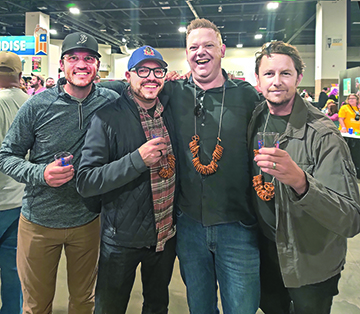
Beer Enthusiasts: These valley residents were excited to be back in person to try some of the best beers from around the country.
“Colorado proves that we are a leader in the craft beer industry and shows that our brewers continue to brew consistently excellent beers in all types of styles,” said Colorado Brewers Guild Executive Director Shawnee Adelson.

Starry Noche: Neil Fisher, Co-Founder, Head Brewer of WeldWerks Brewery, pours Starry Noche at their booth at the 2022 GABF on Saturday, October 8, 2022.
Although it did not win a medal, WeldWerks Brewery from Greeley poured its 2022 vintage of Starry Noche, started as a carefully selected blend of Medianoche batches aged for 20-29 months in a variety of freshly emptied Old Fitzgerald 14-year bourbon, Elijah Craig 19-year bourbon, Sazerac 14-year rye, Blanton’s 8-year bourbon, Eagle Rare 10-year bourbon, and Henry McKenna 11-year bourbon barrels. After resting in these casks for over two years, the blend was conditioned on more than three pounds per gallon of toasted coconut flakes and raw coconut chips and finished with toasted hazelnut.
Overall, there was a buzz inside the Colorado Convention Center. Attendees were excited to be back in person to try some of the best beers from around the country.
“Each year the Great American Beer Festival showcases the best that American brewers have to offer,” said Chris Williams, competition director, Great American Beer Festival. “With 9,904 entries, this year’s competition was the most competitive to date. Congratulations to all the winners who truly demonstrated why the U.S. is the best brewing nation in the world.”
For more information on GABF and to see the list of all the winners, visit www. greatamericanbeerfestival.com. For more information on the Colorado Brewers Guild, visit www.coloradobeer.org. The 41st Great American Beer Festival is set for September 21-23, 2023.
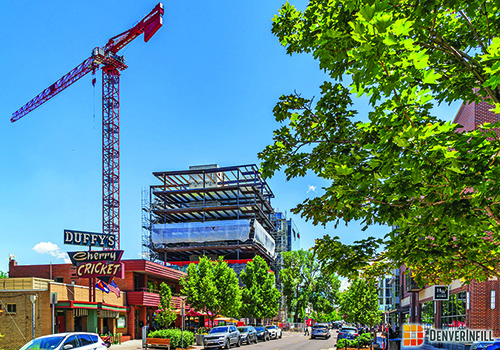
by Valley Gadfly | Oct 21, 2022 | Main Articles
A Flood Of New Construction Is Underway In The District Amid A Flock Of New, Renewed Projects Paused In The Pipeline
by Glen Richardson

Cranes O’er Cherry Creek: Cranes are again in the air over Cherry Creek as district building is booming again. This eight-story project is on the southeast corner of 2nd Ave. as Broe Real Estate Group restarts the makeover of the east side of Clayton St.
Onset of the pandemic gave rise to a welcome respite from non-stop redevelopment of Cherry Creek North that began in 2013. Countless major projects were stuck in the pipeline during the long shutdown. As reopenings picked up the pace in 2022, the neighborhood is again undergoing a construction boom with hordes of new and renewed projects started or proceeding at an unprecedented pace.
As construction cranes again fill the neighborhood, citizens express concern that the once serene shopping district of boutiques and eclectic eateries will become a landscape of glass, brick, and steel. Others fear rapid growth will escalate the districts’ surging crime rate. A check by the Chronicle showed — 2022 vs. 2021 —violent crime in Cherry Creek is up 12.5%; property crime is up 23.2%; car thefts are up 51.1%, and robberies are up 200.0%.
Here’s a look at the flood of new construction, big and small, good and not-so-good, currently underway in the district:
200 Clayton
Substantial headway has been made on the corner office building at 2nd Ave. and Clayton St. Both the cores and steel structure have topped out with fireproofing and facade work underway. It will be an eight-story, 76,000-sq.-ft. high-rise on the southeast corner of 2nd Ave. Built by Broe Real Estate Group, it will feature both retail and commercial space.
The firm owns the bulk of the east side of Clayton St. and the corner site is restarting the transformation of this north-south street.
When 200 Clayton is completed, Broe will demolish the two-story parking garage it owns to the north and build yet another seven-story structure. It is projected to have 3,000-sq.-ft. of ground-floor retail space and 31,890-sq.ft. of office space.
255 Fillmore
In 2016 the Cherry Creek Plaza building was demolished to make way for a seven-story office building. However, the project never broke ground and the site stood as a surface parking lot. Now a new rendition of the project has broken ground with excavation underway. Yet another Matt Joblon project, it is a 100,000-sq.-ft. seven-story building that is 95% leased, with Vietnamese-French eatery Le Colonial taking one of the street-level spots.
300 Fillmore
Just a half-block from 255 Fillmore, another new office project has broken ground. Throughout the boom, Cherry Creek North has seen little development on the north side of East 3rd Ave. due to it being zoned for buildings no higher than four stories. Nonetheless, demolition of a two-story structure is underway, with a four-story, 70,814-sq.-ft. building planned that will include 117 surface parking spaces. The 0.43-acre parcel is where Grind Kitchen, Tazu Sushi, women’s boutique Harriet’s, and jewelry store Element79 were located.
300 University
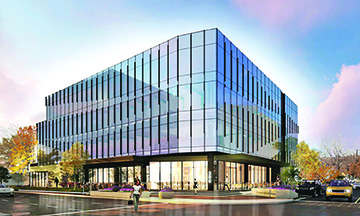 Along Cherry Creek’s western edge, on the north side of East 3rd Ave., a four-story building with 50,000-sq.-ft. of office space and 10,000-sq.-ft of ground floor retail will be built. The project is on a half-acre site where floral-home furnishing store Bloom by Anuschka was located, and includes a parking lot leased to Hillstone Restaurant. The project is a family business of Brent Farber of Elevation Development and his uncle, Rick Sapkin, of Edgemark Development. Sapkin has owned the property for more than 30 years.
Along Cherry Creek’s western edge, on the north side of East 3rd Ave., a four-story building with 50,000-sq.-ft. of office space and 10,000-sq.-ft of ground floor retail will be built. The project is on a half-acre site where floral-home furnishing store Bloom by Anuschka was located, and includes a parking lot leased to Hillstone Restaurant. The project is a family business of Brent Farber of Elevation Development and his uncle, Rick Sapkin, of Edgemark Development. Sapkin has owned the property for more than 30 years.
180 Madison St.
Modera Cherry Creek is making great progress on an apartment project in Cherry Creek East. The five-story structure is on the southeast corner of 2nd Ave. & Madison St. It has topped out, a brick-focused facade making its way up the building. First move-ins are expected this fall in the complex, which will feature a mix of studio, one-, two-, and three-bedroom units as large as 2,044-sq.-ft.
Slew Set To Be Built 155 & 165 N. Cook
Mill Creek is planning a second project similar to their Modera Cherry Creek a block away. Plans as recent as May have been filed with the city. However, some individual plans require resubmittal. The site is on the southwest corner of 2nd Ave. and Cook St. The project is replacing a pair of three- and four-story office buildings.
299 Milwaukee
The southwest corner of 3rd Ave. and Milwaukee St. may see a new eight-story residential building. Currently, the parcel is occupied by a plaza and two-story parking structure.
242 Milwaukee
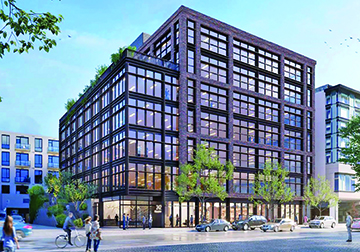
Hip High End Offices: With low inventory and high demand, new office buildings are adding to the district’s building boom. This proposed seven-story project is mid-block on Milwaukee St.
There is a lot of interest in office development in Cherry Creek North. This proposed project is between East 2nd and 3rd Ave., mid-block along Milwaukee St. Plans call for a seven-story office building that would replace a two-story retail structure.
201 Fillmore
An eight-story office building is being planned at the northwest corner of East 2nd Ave. and Fillmore St. The building would replace the single-story retail space that currently houses a Men’s Warehouse plus an adjacent parking lot.
329 Detroit
A small condo project has been proposed for a parcel mid-block on Detroit St. between East 3rd and 4th Ave. The five-story project would replace a single-story building that was the Witold-K Art Studio & Gallery for 40 years. The Denver artist’s work is in museums and galleries worldwide. He participated in the New York Graphic Masters exhibition with Picasso, Chagall, and Miro, and was the first American to have works displayed at Sotheby’s in Amsterdam.
Mall’s West End
As the Chronicle reported in March, East West Partners is planning to build seven structures up to 12 stories tall at the west end of the Cherry Creek Shopping Center. Plans call for the first four buildings to have 780,000-sq.-ft. of office-retail space, plus three condo-apartment homes with 600 units.
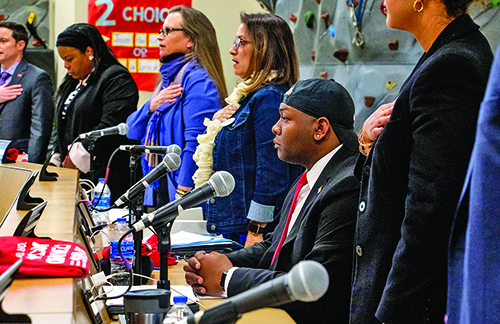
by Valley Gadfly | Sep 30, 2022 | Main Articles
Student-Teacher Ratio, Salaries, School Board Squabbles
Drop Denver District’s Learning To The Lowest Level Ever
by Glen Richardson
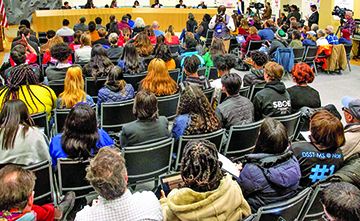
Brimful Classes, Bickering Board: Crammed classrooms and squabbling schoolboard has plummeted Denver schools to the lowest level of academic learning ever.
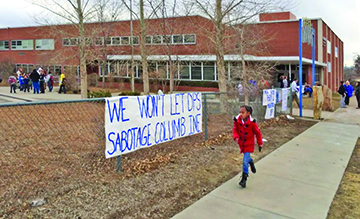
Parent Protest: Parents are confused and angry as DPS teachers and principals leave or are replaced at schools. Principals at 46 of the district’s 134 non-charter schools were new to their position, their school, or both this year.
With Denver’s new school year now in full-swing, the turbulent return for students has been a rollercoaster of feelings, from worry and uncertainty to apathy. Despite reuniting with friends and peers bringing joy, the process of reentry is jarring and chaotic due to the short supply of classroom teachers coping with larger class sizes, fewer aids, a lack of supplies, and a dysfunctional school board. Comprised of nearly 200 schools — including traditional, magnet, charter, and pathways — the Denver Public School System has an enrollment of more than 92,000 students.
A total of 440 teaching positions were unfilled statewide as the 2022-23 classes started. Sorrier yet, another 1,128 or 20% were filled by hiring long-term substitutes, retired educators, alternative licensure program candidates, and “emergency authorization” candidates. The previous year (2021-22) 235 teaching vacancies remained unfilled for the entire school year and another 13% were filled by shortage mechanisms.

Board Bad Boy: School Board’s Tay Anderson continues to create chaos and erode community support. He is shown here refusing to stand during the Pledge of Allegiance. Photo: Kevin J. Beaty, Denverite
When it comes to public education, Colorado is at the bottom of the barrel: The state has the eighth lowest average teachers’ pay of all states. Furthermore, it has the 11th highest student-to-teacher ratio in the nation at 31 students per teacher. The Outcome: Colorado’s high school graduation rate is the sixth lowest in the nation at 79.1%.
On The Ropes
Schools in Denver and statewide are at a critical point: Teachers are stressed, overworked, and exhausted. After the tremendous pressures of the past two years, many have reached the end of their rope, tied a knot, and are barely hanging on.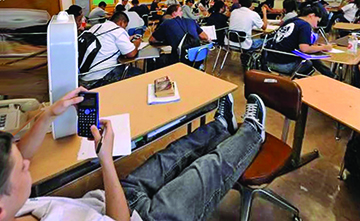
Meanwhile, second graders need to learn kindergarten and first grade academic and social skills while sixth graders are grappling with fourth and fifth grade concepts. Even if classes weren’t huge, teachers feel triple the workload within each child.
A survey by the Colorado Education Association found that 40% of licensed teachers statewide are considering leaving the profession. For those teaching this year, pandemic burnout, low pay, and rising housing costs are the driving factors as they contemplate leaving the classroom. The kids are the only thing that makes that decision hard.
pay, and rising housing costs are the driving factors as they contemplate leaving the classroom. The kids are the only thing that makes that decision hard.
Learning Plummets
Academic learning in Denver has plummeted relative to other school districts in the state. In 2021, Denver Public Schools recorded the lowest level of academic learning ever, performing worse than all other large Colorado districts. Heretofore, Denver’s growth scores were beyond 50 every year for over a decade, outperforming nearly every school district in the state.
Among worrisome Denver scores were 22nd percentile growth for sixth-grade math, and 40th percentile growth for fifth-grade literacy. Denver’s fourth-grade students math achievement in 2021 was 7% proficient. In 2019, fourth-grade students were at 18% proficiency. Another troubling trend: For at least the past five years, the percentage of kindergarten-through-third-grade students who scored “significantly below grade level” on fall reading tests has hovered around 22%.
On the whole, Denver’s CMAS scores rebounded from last year, though not back to pre-pandemic levels. The one positive exception was third-grade reading, where the percentage of students meeting expectations — 39.9% — was slightly higher than in 2019. On the PSAT and SAT, however, Denver’s scores were lower than in 2019 or 2021. Students struggled the most in math. Just 29% of 11th graders met expectations on the math SAT. It’s long overdue for Denver’s district leadership to drop the magical thinking and honestly address the challenge of educating more than 92,000 students, submits Van Schoales, a Senior Policy Director at the Keystone Policy Center and former President of A+ Colorado.
Unproven Principals
Denver Public Schools opened its doors this year to more new principals than it has in at least six years. Principals at 46 of the district’s 134 non-charter schools — or 34% — were new to their position, their school, or both this year, according to district information. Sixteen of the new principals moved into the position from that of assistant principal.
If the 11 principals who simply moved laterally — jumping from the leadership of one Denver school to another — are not counted in the total, DPS still has 35 new principals. More: Twelve of the principals are external hires, new to DPS.
Henry Roman, president of the Denver Classroom Teachers Association, believes the district should focus on encouraging experienced teachers to enter its principal pipelines because he believes candidates with a strong background in instruction and curriculum development are needed. He’s also concerned that the DPS Ritchie Program for School Leaders at DU draws too much from a young, inexperienced pool of prospects.
School Board Squabbles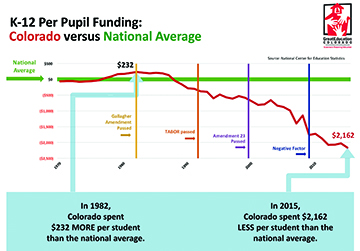
Even if DPS wasn’t already boiling over with troubles, the current Denver School Board may be the most counterproductive and contemptuous ever. Creating chaos, confusion, and uncertainty, members have eroded community support while sidetracking student and teacher problems and concerns.
Responsible for setting policy for Denver Public Schools, members in work sessions disagree on matters as small as whether to call each other by their first names and as big as how to gather feedback from the community. The board spent much of this winter-spring debating a single policy related to school autonomy and teachers’ rights. That, according to critics, left little time to talk about important issues such as helping students learn to read and improving their mental health.
At a meeting to fill a vacant board seat, it took nine rounds of voting and several heated and emotional exchanges for a majority of members to agree. A consultant specializing in conflict resolution was asked to attend a mid-June retreat. She reported the group’s energy was filled with “mistrust, fear, and hesitation.”
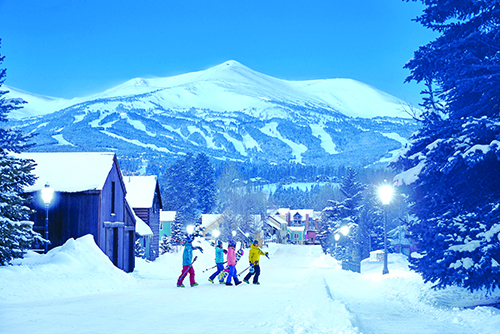
by Jessica Hughes | Sep 30, 2022 | Main Articles
by Jessica Hughes

Skiing the fresh powder at Vail Mountain. Photo: Andrew Maguire, Breckenridge Ski Resort

Ski runs at Breckenridge along the Tenmile Mountain Range. Photo: Andrew Maguire, Breckenridge Ski Resort
It’s that time of year again, when fall signals the anticipatory announcements of opening day for Colorado ski resorts and the race to be the first to open begins.
On August 22, 2022, Vail Resorts announced their opening dates of its five Colorado resorts including Vail Mountain, Beaver Creek, Breckenridge, Keystone, and Crested Butte. The season begins with Keystone Resort set to be the first to open in mid-October and ending with the closing of Breckenridge running well into May, making this one of the longest seasons in the country for its Epic Pass Holders.
The race to the top is tight with Keystone Resort planning to be the first to open in all of Colorado on October 21, rivaling Arapahoe Basin which is set to open on October 22. Historically, the average opening date for the upcoming ski season has been October 22.
In addition, to the opening dates, the company shared it will limit lift ticket sales throughout the season in an effort to manage potential overcrowding. “We care deeply about our guests’ experience at our resorts,” said James O’Donnell, president of Vail Resorts’ Mountain division.
“Limiting lift tickets throughout the season, alongside the big investments we’re making at our resorts, and in our team members, will help us provide our guests with an Experience of a Lifetime this winter.”
Much of this came in response to issues the resort has experienced in past years with long lift lines and overcrowded runs. Pre-purchased passes, including the Epic Day Pass, are not limited, and if tickets are sold out online, guests will not be able to purchase at the window.

Downtown Breckenridge rests near the base of the resort. Photo: Andrew Maguire, Breckenridge Ski Resort
Aside from opening dates announcements, the winter 22/23 season ushers in exciting news from Colorado’s 26 ski areas and resorts with notable milestones, upgrades, and new additions.
Vail Resorts is investing $300 million in the guest experience this season, with new lifts at Vail and Breckenridge, a restaurant expansion at Keystone, and exciting events at all five resorts.
Vail Mountain will unveil its new two-lift project, introducing the Sun Down Lift, a new high-speed 4-person chair that will connect the bottom of Sun Down Bowl to Wildwood, allowing for a smoother connection between Lionshead Village and the Seven Legendary Back Bowls. The lift in Game Creek Bowl will also be upgraded to a new high-speed six-person lift.
Steamboat Resort continues to move forward with its second phase of a multi-million, multi-year transformation of its base area, including an ice-skating rink and new food and drink hall, while World Cup downhill racing returns to Aspen Mountain this spring.
North America’s highest-elevation restaurant re-opens at Arapahoe Basin as the completely renovated and expanded il Rifugio, a European-inspired full-service eatery, while down the road Loveland Ski Area will launch a guided snowcat operation offering backcountry trips for intermediate level and above skiers and snowboarders beginning in January of 2023.
Colorado’s oldest ski area in continuous use since 1915, Howelsen Hill in Steamboat, will open a new snow tubing area and lift to debut this December. This season also marks a few historic milestones. Telluride Ski Resort and Copper Mountain will celebrate their 50th anniversaries, and Eldora Ski Area and Vail Mountain will celebrate their 60th anniversaries.
Opening dates for the winter 22/23 season in Colorado*:
Keystone: October 21, 2022
Arapahoe Basin Ski Area: October 22, 2022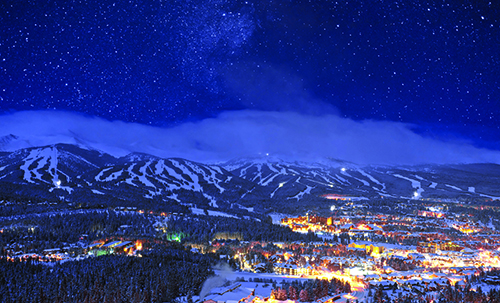
Wolf Creek Ski Area: October 29, 2022
Loveland: October 29, 2022
Aspen Snowmass: November 10, 2022
Breckenridge: November 11, 2022
Vail: November 11, 2022
Winter Park: November 17, 2022
Eldora Mountain Resort: November 18, 2022
Purgatory: November 20, 2022
Copper Mountain: November 21, 2022
Beaver Creek: November 23, 2022
Crested Butte Mountain Resort: November 23, 2022
Aspen Mountain: November 24, 2022
Telluride: November 24, 2022
Steamboat: November 26, 2022
Powderhorn: December 03, 2022
Ski Granby Ranch: December 9, 2022
Aspen Highlands: December 10, 2022
Cooper: December 10, 2022
Monarch Mountain: December 10, 2022
Howelsen Hill: December 10, 2022
Echo Mountain: December 10, 2022
Buttermilk: December 17, 2022
Sunlight Mountain Resort: December 17, 2022
Silverton Mountain: December 24, 2022
*all dates are subject to change based on weather conditions.
Source: https://www.onthesnow.com/colorado/projected-openings

by Charles Bonniwell | Sep 30, 2022 | Main Articles
Zoning War Possible Between Cities
by Charles C. Bonniwell
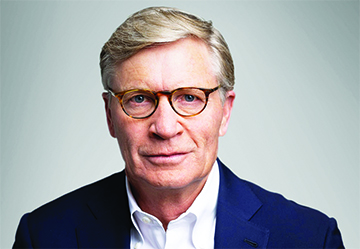
High Density King: David Tryba, Principal of Tryba Architects. His firm has submitted a “Concept Site Plan” for an area that borders Glendale along Cherry Creek Drive South that includes 15 and 20 story apartment buildings. In 2016, his firm proposed buildings to be constructed in Glendale that would have been the tallest in the state. Glendale officials rejected the concept.

Site Plan: The concept site plan submitted to the Denver Planning Department by Tryba Architects includes five buildings along Cherry Creek Drive South and East Kentucky Avenue with buildings 4 and 5 bordering Glendale and totaling 20 and 15 stories respectively.

Tall Buildings: The red lines in the above photo illustrate how tall the proposed buildings would be if approved by Denver’s Planning Department. They would be 157 feet and 210 feet respectively and block out any views East along Cherry Creek Drive South from Glendale.
The massive density along Cherry Creek within the City and County of Denver appears to be continuing unabated with the creek being canyonized by tall buildings. High density developers’ favorite architectural firm, Tryba Architects, has submitted a “Concept Site Plan” for 5250 East Cherry Creek Drive South to Denver Planning and Development that has surrounding neighborhoods and the City of Glendale in an uproar.
David Tryba, the head of Tryba Architects, had come along with Dana Crawford, to Glendale City Hall in February 2016, to convince city officials to allow a massive tower of luxury apartments/condominiums. The building would have been potentially the tallest building in Colorado and located along 3.8 acres acres of land owned by the proprietors of Authentic Persian and Oriental Rugs on Colorado Boulevard. At his meeting with Glendale officials, Tryba
Continued on page 4
Continued from page 1#
noted how landowners could make a great deal more money the more density they can squeeze on a property. He stated that they had come to Glendale because they were “frankly interested in having more flexibility than they could have in Denver in terms of being able to go vertically.”
Community And Glendale Objections
Glendale was not impressed and did not approve the concept, but Denver in the waning days of the Hancock administration has become more “flexible” than it was previously. The Glendale City Council directed its staff to oppose the 5250 East Cherry Creek Development due to its extreme density and asked them to point out “the serious negative impacts to traffic, parks, and the surrounding lower density Denver and Glendale neighborhoods, and encouraged a development that is “more compatible adjacent zoning and density.”
Glendale did not object to a redevelopment of the present site which has 328 units and a density of 28 units per acre. Glendale notes the redevelopment would drastically increase the number of units to 1,232 with 196 units per acre — a fourfold increase. The redevelopment would be comprised of five buildings with the two tallest being 15 and 20 stories and back up to one and two-story buildings in Glendale. In one property in Denver, there would be 40% of all residential units in Glendale combined.
Both Cherry Creek Pediatrics and the Board of the Cedar Pointe Condominiums have sent objection letters to the Denver Planning Department pointing out many of the problems that the size and mass of the buildings could effectively destroy the existing landscaping in Glendale.
Parking And Traffic
Glendale in its correspondence noted the enormous parking and traffic problems that the project would bring. Denver allows as little as 1.5 parking places per unit while Glendale requires much more plentiful parking but does not allow on street parking. Adjacent Cedar Point Condominiums has 573 off-street parking for 270 units. The overflow parking from the project would therefore be forced into Denver’s Virginia Village neighborhood streets and overwhelm them.
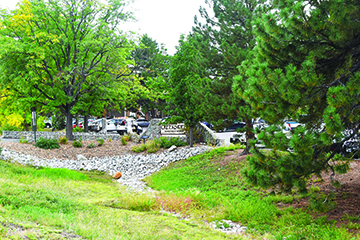
Proposed Site: Creekside Apartments, which has 328 units, currently sits on the property that is most likely going to give way to a massive development sprawled over 11.632 acres.
Traffic created by the redevelopment would create bottlenecks on Cherry Creek South during rush hours and double the traffic on East Kentucky Avenue. The redevelopment does not provide a full signalized intersection with pedestrian crossings. Glendale points out that the redevelopment is not consistent with the 2010 Blueprint Denver which provides for low to medium residential development for the area.
Rezoning And Possible Zoning War
The property had been zoned R-2-A with height limitations but in 2006 rezoned to R-3 with no height limitations. To obtain the rezoning the property owner, Apartment Income REIT Corp agreed to waive its unlimited heights rights to protect the R-2-A Denver property to the south but no protection for any Glendale property to the west. The setback on the Glendale side is proposed to be only 20 feet dwarfing the Cherry Creek Pediatric Center in Glendale. Denver appears to be allowing massive density adjoining Glendale properties. This could result in Glendale in turn rezoning its properties along the Denver border with massive density.
Such a zoning war would hurt both cities, but Glendale may have little choice given Denver Planning Commission’s seemingly willingness to badly damage Glendale.
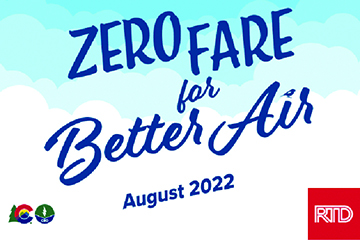
by Valley Gadfly | Aug 26, 2022 | Main Articles
Free August Fares Sought To Clear The Air, Lift Ridership, But Weekday Rides Jump Just 16% Due To Drug, Crime Worries
by Glen Richardson
 Reeling from the pandemic, changing work patterns, and lingering worker shortages, while grappling with drug use and crime, RTD is facing a ridership crisis that threatens to cripple or collapse the transit agency.
Reeling from the pandemic, changing work patterns, and lingering worker shortages, while grappling with drug use and crime, RTD is facing a ridership crisis that threatens to cripple or collapse the transit agency.
RTD’s month-long August “Zero Fare for Better Air” promotion drew only 16% more weekday boarders during the first week when “free” was expected to double ridership. The weekend — with live theatre, Broadway shows, and baseball — did double rides. The agency estimates it will lose $9.2 million in fare revenue during the month. The state approved an $8.7 million grant — Senate Bill 180 — for the fare free program. RTD is responsible for picking up the balance.
Whenever you say free, many contend, “It’s not free, someone is paying!” In RTD’s latest free foray, many expressed concerns that making it free would attract homeless riders, plus increase unruly behavior and criminal activity. Some said it was likely to attract drunk-disorderly riders. “It’s an awful idea and will chase away paying patrons, if it hasn’t so far,” others intimated.
Slow Start Scramble

Crime Clogs Air Campaign: Drug, crime worries clogged RTD’s August Zero Fare for Better Air campaign as the transit agency’s buses, trains can’t find the combustion to attract commuters.
At the start of Zero Fare’s second week — safety and security issues were clearly crippling ridership. A series of outreach events with RTD Transit Police and Denver Police were quickly added. The four events — the first on Aug. 10 — were coffee chats designed to engage with potential customers and the community about security, service, and the Zero Fare incentive.
In March the agency hired Steve Martingano as RTD Police Chief. He has 22 officers to cover 2,300-sq.-miles. In June, RTD also approved a one-year contract extension with Allied Universal Security Services for up to $20.3 million.
RTD impact teams try to head off problems before customers board. Bus operators are asked if there are any problems on buses, seeking to ensure trips operate safely. At Union Station — where customers, employees, and visitors say they feel unsafe, and at least one business closed over crime — RTD is working with police, who have stepped up patrol. Denver Police made more than 800 arrests in and around Union Station in the six-months between November 2021 and April 30 of this year.
RTD’s System, Riders
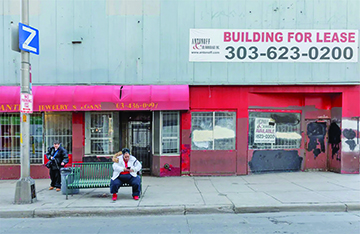
Bus Boondoggle: RTD’s bus network is adequate, but bus stops often aren’t more than a pole with a small sign. Sometimes there’s a lonely bench, but only 5% have shelters.
RTD’s metro service includes six light rail lines, two commuter rail lines, and 84 local-regional bus routes. There are more than 340,000 daily transit trips. Approximately 230,000 of the trips — or about two-thirds — are within Denver.
Annual ridership in 2021 included 6,585,500 commuter rail, and 10,016,300 light-rail riders. That compares to 4,954,167 on commuter rail in 2020, and 10,464, 678 on light rail. Bus boardings in 2021 were 31,598,000 compared to 32,932,000 in 2020.
In 2019 there were 9,711,377 commuter rail and 24,585,300 light rail boardings. Bus boardings in 2019 totaled 59,685,653.
Cars In Control
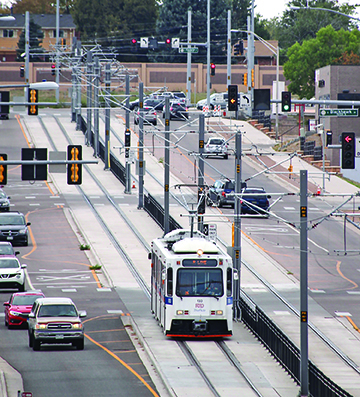
Cars Dominate Commute: Traffic on Valley highways and arterials at near-normal levels whereas RTD is still struggling to attract ridership for commuter trains and buses.
RTD hoped its Zero Fare for Better Air would attract customers by saving them money and reducing stress. It aimed to limit air pollution and ground-level ozone. The agency has added a 36 battery-electric sub-fleet on the 16th St. Mall and purchased an additional 17 zero-emission buses, as its better air commitment.
Nonetheless, RTD struggled despite free fare. Federal monitoring of traffic on the state’s highways-arterials, shows traffic at near-normal levels. Volume, at times, actually exceeds 2019 monthly totals. That’s true, even as the Valley’s weekday rush hours have changed.
Based on several studies, for Denver drivers to switch from their cars to riding buses and trains would require frequencies of every 15 minutes. That is far from the 30-minute standard here and in other cities.
Fab Hub Fades Fast
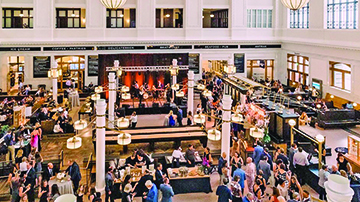
Fall Of Great Hall: Opening in 2014, Union Station’s Great Hall initially attracted 10 million people annually. Today it is depicted as a hotbed of violence and drug dealing.
Union Station — the $54 million renovation of the 1914 Beaux-Arts train station that opened in 2014 as RTD’s transit hub — was initially an amazing place. Located at 17th and Wynkoop, it included the historic, station house, a modern open-air train shed, and a 22-gate underground bus-light rail station.
It encompasses the Great Hall and Crawford Hotel plus dining-retail space. A popular weekend and holiday getaway spot for locals and travelers, it attracted more than 10 million people and featured dozens of free community events annually.
Eight years later it is depicted as a hotbed of violence and drug dealing. The Union Station neighborhood was consistently Denver’s 2021 second most crime-ridden neighborhood, according to Denver’s crime mapping. RTD has shut down bus terminal public restrooms and may corner-off a section of the terminal for those with paid fares.
X-Factor: Commuters
 Even prior to the pandemic, RTD confronted several years of gradual and puzzling ridership drops. Ridership fell about 5% from 2014 to 2019, with a bigger 2019 bump.
Even prior to the pandemic, RTD confronted several years of gradual and puzzling ridership drops. Ridership fell about 5% from 2014 to 2019, with a bigger 2019 bump.
Ridership bottomed out at 30% of normal in the spring of 2020. Even as riders slowly return, recovery remains uneven. Buses attracted just 56% of the riders in November of last year as it did in the same month of 2019. Even with fewer trips, train ridership is performing at 37% to 48% of 2019.
The struggle to attract riders continues, with monthly data through last November indicating that about 53% of riders have returned.
Bus, Train Troubles
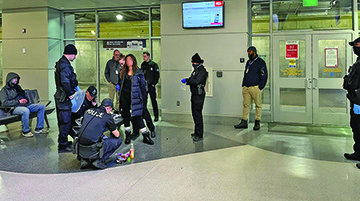
Crime Crisis: Not only did security worries cripple the better air campaign, RTD’s transit hub has been the scene of more than 1,200 arrests and tickets in the last six months.
Where RTD’s bus network has frequent service, it correlates well to population density. Service, however, is less reliable and stop amenities are lower quality. Thus, ridership lags despite buses going where people want to go. Meanwhile, RTD and Denver Police are literally trying to reclaim Union Station’s bus terminal. Planned security upgrades should help.
Denver’s light rail focuses on suburban-downtown trips. Service and amenities are decent, albeit stops often aren’t in useful spots and trains don’t show up on schedule.
A series titled “Ghost Train” is the focus of a CPR podcast miniseries that contends the ambitious, costly rail lines “have done relatively little to shift people around the region and is a story of disappointment and betrayal.”





























